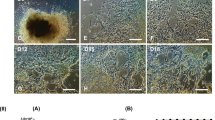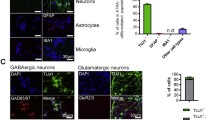Summary
The embryonal carcinoma cell line P19 is derived from mouse teratocarcinomas. These pluripotent cells can be induced to differentiate into a variety of cell types by exposure to various drugs. We used retinoic acid to induce embryonal carcinoma cells to differentiate into neuronlike cells. In this study, we show that changes occur in mitochondria during differentiation of embryonal carcinoma cells to neuronlike cells. We found that various morphologic parameters such as mitochondrial fractional area and mitochondrial size decrease as embryonal carcinoma cells differentiate into neuronlike cells. Similar changes were also observed in mitochondrial DNA content. Stereologic analysis of cell preparations provided a measure of mitochondrial fractional area per cell and mtDNA content was assessed by radiolabeled mtDNA probe. This study establishes that mitochondria are regulated as cells differentiate.
Similar content being viewed by others
References
Bogenhagen, D.; Clayton, D. A. The number of mitochondrial deoxyribonucleic acid genomes in mouse L and human HeLa cells. J. Biol. Chem. 249:7991–7995; 1974.
Collins, J. M.; Foster, K. A. Differentiation of promyelocytic (HL-60) cells into mature granulocytes; mitochondrial-specific Rhodamine 123 fluorescence. J. Cell Biol. 96:94–99; 1983.
Goto, K.; Hayashi, S.; Shirayoshi, Y., et al. Exogenous δ-crystallin gene expression as probe for differentiation of teratocarcinoma stem cells. Cell Differ. 24:139–148; 1988.
Jones-Villeneuve, E. M. V.; McBurney, M. W.; Rogers, K. A., et al. Retinoic acid induces embryonal carcinoma cells to differentiate into neurons and glial cells. J. Cell Biol. 94:253–262; 1982.
Jones-Villeneuve, E. M. V.; Rudnicki, M. A.; Harris, J. F., et al. Retinoic acid-induced neural differentiation of embryonal carcinoma cells. Mol. Cell. Biol. 3:2271–2279; 1983.
McBurney, M. W.; Jones-Villeneuve, E. M. V.; Edwards, M. K. S., et al. Control of muscle and neuronal differentiation in a cultured embryonal carcinoma cell line. Nature 299:165–167; 1982.
McBurney, M. W.; Rogers, B. J. Isolation of male embryonal carcinoma cells and their chromosome replication patterns. Dev. Biol. 89:503–508; 1982.
McBurney, M. W.; Reuhl, K. R.; Ally, A. I., et al. Differentiation and maturation of embryonal carcinoma-derived neurons in cell culture. J. Neurosci. 8:1063–1073; 1988.
Nass, M. M. K. Mitochondrial DNA: advances, problems and goals. Science 165:25–35; 1969.
Papaioannou, V. E. Interactions between mouse embryos and teratocarcinomas. INSERM (Int. Nat. Sante Rech. Med.) Symp. 10:141–155; 1979.
Rudnicki, M. A.; McBurney, M. W. Cell culture methods and induction of differentiation of embryonal carcinoma cell lines. In: Robertson, E. J., ed. Teratocarcinomas and embryonic stem cells: a practical approach. Oxford, England: IRL Press; 1987:19–49.
Sporn, M. B.; Roberts, A. B.; Goodman, D. S. The retinoids, vols. 1,2. New York: Academic Press; 1984.
Spurr, A. R. A low-viscosity epoxy resin embedding medium for electron microscopy. J. Ultrastruct. Res. 26:31; 1969.
Strickland, S.; Mahdavi, V. The induction of differentiation in teratocarcinoma stem cells by retinoic acid. Cell 15:393–403; 1978.
Veltri, K. L.; Espiritu, M.; Singh, G. Distinct genomic copy number in mitochondria of different mammalian organs. J. Cell. Physiol. 143:160–164; 1990.
Williams, R. S.; Salmons, S.; Newholme, E. A., et al. Regulation of nuclear and mitochondrial gene expression by contractile activity in skeletal muscle. J. Biol. Chem. 261:376–380; 1986.
Williams, R. S. Mitochondrial gene expression in mammalian striated muscle. J. Biol. Chem. 261:12390–12394; 1986.
Author information
Authors and Affiliations
Additional information
This study was financially supported by the Medical Research Council of Canada.
Rights and permissions
About this article
Cite this article
Singh, G., Veltri, K.L. Effects of differentiation of embryonal carcinoma cells (P19) on mitochondrial DNA content in vitro. In Vitro Cell Dev Biol - Animal 27, 557–561 (1991). https://doi.org/10.1007/BF02631286
Received:
Accepted:
Issue Date:
DOI: https://doi.org/10.1007/BF02631286




